Showing top 0 results 0 results found
Showing top 0 results 0 results found

In today's fast-paced environment, it might seem impossible to keep users engaged for even a couple of seconds—and the fact that many companies are fighting for their attention doesn't make it any easier.
The good news is, that there are multiple strategies you can use to captivate visitors and increase your website's session duration.
What is the session duration?
Average session duration is the average time users spend on your website. A session starts when someone visits a page on your site and ends when they leave your site or after 30 minutes of inactivity.
Why session management matters
One of the metrics Google uses to rank your website is user experience. Long average session duration will let Google and other search engines know that visitors find your content engaging and valuable, which will lead to an increase in rankings.
Longer session durations are also associated with higher conversion rates. This makes sense because a user who spends a lot of time on your site is more likely to become a repeat buyer or convert into a lead.
Now that you have a better understanding of what session duration is and why it matters, let's go over seven tricks to keep your visitors engaged.
7 Strategies to Increase Session Duration
Now that you have a better understanding of what session duration is and why it matters, let’s go over seven tricks to keep your visitors engaged.
1. Optimize your website’s design
Cluttered navigation menus, pop-ups showing up every few seconds, a complicated site structure, and fonts too small to read—all of these things are signs of poor website design that can send your visitors packing.
Not surprisingly, intrusive interstitials and mobile responsiveness are two of the hundreds of signals Google uses in ranking.
For example, let’s take a look at the website below.
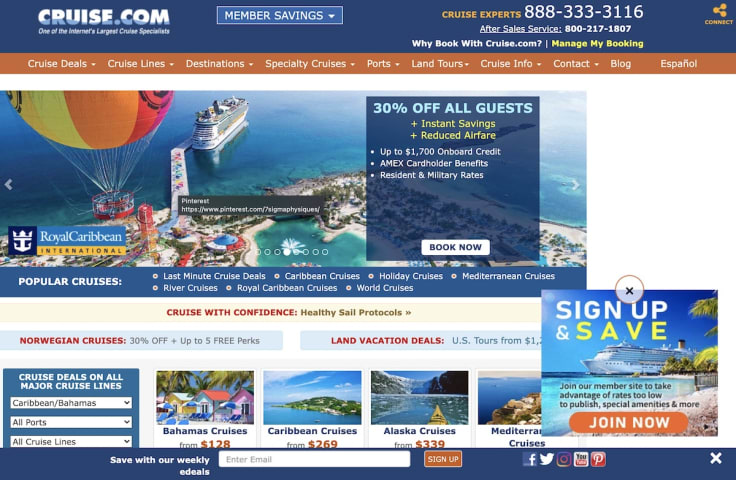
This website includes three different call-to-actions (CTAs), two pop-ups, and a lot of different unorganized links that make the experience feel overwhelming.
Now look at how much cleaner and better organized this second website looks; it just keeps the reader's attention.
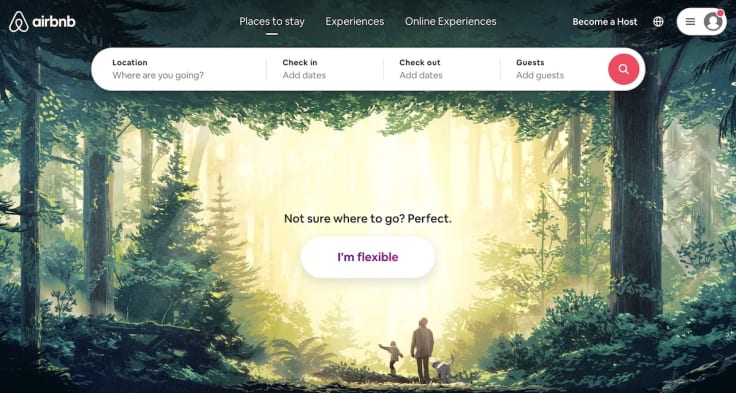
Here are a few things you want to take into consideration when optimizing your website’s design:
- Keep important content above the fold - Visitors should see what they’re looking for as soon as they land on the page without having to scroll or click anywhere.
- Keep it simple - Don’t include too many different CTAs. Try adding only the most relevant CTA to prevent visitors from overthinking and not performing the action. Basically, you want to tell visitors what their next step should be.
- Make it mobile-friendly - A large number of the population now views websites on their phones, therefore, it’s crucial that your website displays perfectly on different screen sizes. In fact, Google uses the mobile version of your content for indexing and ranking.
- Use a legible font size - Different fonts can be more or less legible even at the exact same size, however, 16 px is typically a good place to start.
- Leave a good amount of space between links - Having clickable elements too close together can be an issue on devices with smaller screens, such as phones and tablets.
- Use a table of contents - If you tend to write long and in-depth content, consider adding a table of contents so visitors can go directly to the section they want to read about.
- Break up text with engaging images - Seeing a huge wall of text can be a turn-off for many people—including me. Adding relevant infographics and charts is a great way to not only break up the text but keep your visitors engaged.
2. Create relevant content
Have you ever clicked on the top result in Google but didn’t find what you’re looking for? Then clicked on the next result and found the same information?
When writing content, you want to make it original and engaging, don’t just regurgitate what other people have written. Use your own unique voice and write as though you were talking directly to your reader. You should always strive to create content your target audience finds interesting, valuable, and useful.
Creating this type of content can be difficult and time-consuming. However, there are advanced copywriting tools powered by artificial intelligence (AI) that can speed up this process.
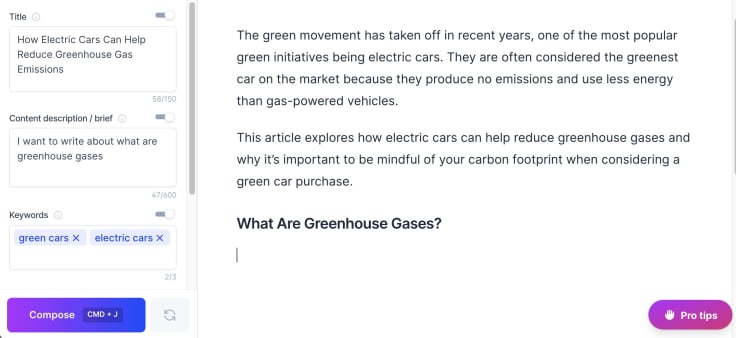
For example, software like Jarvis AI can quickly generate sales copy, social media captions, cold emails, and help you write human-like blog posts faster. You also have the option to include a “tone of voice” to give your articles a unique point of view.
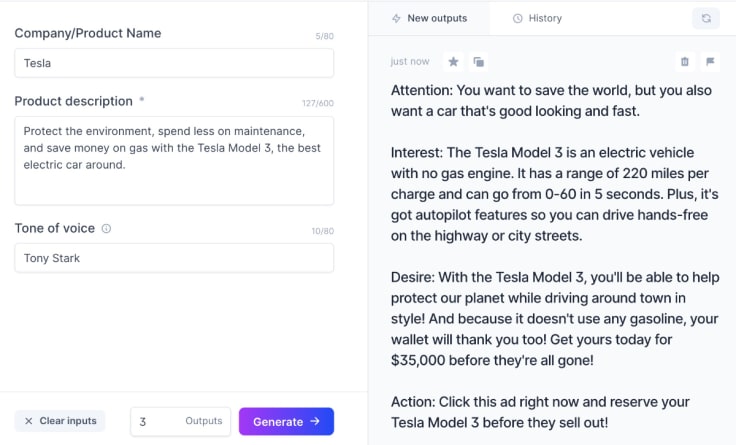
You could write using tones like “happy,” “encouraging,” or “condescending” or using famous or fictional figures like “Joe Rogan,” “Harry Potter,” or “The Rock.”
3. Improve site speed
A website's load time is super important.
A study released by Google showed that 53% of visitors leave a site if it takes more than three seconds to load and that there is a strong correlation between page speed and session duration.
Additionally, in June 2021, Google began rolling out its page experience update that takes into account three Core Web Vitals—site speed, user experience, and visual stability—to rank websites.
There’s no shortage of things you can do to speed up your website, but here are the ones that’ll have the most impact:
- Choose a good web host - Shared hosts tend to overcrowd their servers, which leads to slower page speeds, downtimes, and security issues. When it comes to mission-critical websites, using a managed WordPress host like Rocket.net will increase your server response time and keep your website snappy.
- Build using a lightweight theme - While multi-purpose themes might seem like a good idea, all the unused extra features will still load on the background, slowing your site down. When choosing a WordPress theme, it’s often a good idea to go for a well-coded one that only has the features you need.
- Set up caching - A caching plugin like FlyingPress will save a copy of your site’s files in a temporary location so that they can be delivered quickly to visitors instead of having to load everything from scratch.
- Compress images - Large images can really drag your site speed down, so consider running them through a free tool like Optimizilla before uploading them to your website.
4. Add a live chat feature or a chatbot
Another great strategy to increase session duration is by adding a live chat feature or an AI chatbot to your website.
A live chat will allow you to communicate with your website visitors in real-time. If you use the right tool, you can have an ongoing 2-way conversation with them which will make them feel like you are really listening to what they have to say. This will encourage them to stay on your site and browse around. Plus, it’ll give them the opportunity to ask questions and get answers quickly and easily.

Using a chatbot instead of a human is much faster and less expensive. These AI-powered tools use natural language processing (NLP) and algorithms to mimic human-to-human conversations, learn from previous customer interactions, and improve over time.
5. Add internal links within articles
Another great way to increase session duration is to include links to other relevant articles on your website within your blog posts.
Besides increasing traffic to other articles, this also helps spread “link juice” or “page rank” to other pages and improves crawling and indexing by Google and other search engines.
For example, if you had a blog post about the positive effects electric vehicles have on the environment and another one about the top ten electric cars, you could have them link to each other.
Here are some internal linking best practices:
- Use descriptive anchor text - Instead of adding links to texts like “click here” or “learn more,” use descriptive texts, such as “best protein powders” or “learn to drive.”
- Don’t use your target keyword as an anchor text - For example, if you’re writing an article that targets the keyword “increase credit score,” don’t link to another article using that keyword.
- Link to your more important pages - Linking to your top pages will allow you to pass “link juice” and boost their rankings.
- Don’t overdo it - Don’t litter your blog post with links, even if they’re to your own website. Just add the most relevant ones that you believe someone reading the current article would be interested in.
- Consider adding a related posts section - If you want, you could add a related post widget to your sidebar or at the bottom of the article.
6. Monitor broken links
Earlier, we went over how important it is to include internal links within your articles. Now imagine one of your visitors is deeply invested in your piece and notices there’s a link offering more information. They click it, only to be greeted with a 404 page not found error.
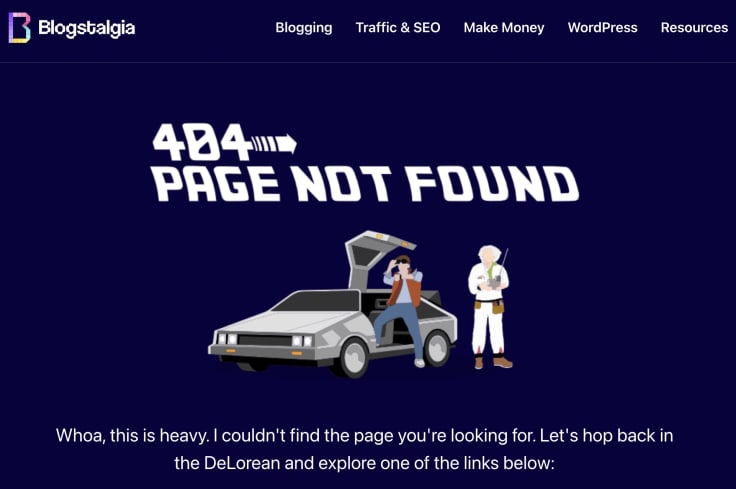
How do you believe they’re going to feel?
They’re most likely going to lose a bit of interest in the content and possibly even click away. Broken links can negatively affect your visitors’ overall experience, decrease session duration, increase bounce rates, and lead to a drop in conversion rates.
For this reason, you want to make sure that you keep an eye on your links—especially after deleting blog posts or changing URLs. Luckily, this can be done easily with a free tool like Broken Link Checker.
7. Include concise and eye-catching CTAs
A CTA is a marketing term that refers to the next step you want your website visitors to take—like subscribing to your newsletter, buying a product, or signing up for your webinar. Think of them as the “kick” your reader needs to get them going down the patch to complete an action.
Become our Partner and turn clicks into revenue
Promote our products and earn a steady stream of income!

Here are some tips to help you optimize your CTAs:
- Be concise - CTAs that are too wordy are not as effective as brief ones. Basically, you want to keep your text short and sweet. No more than four words would be ideal. Think phrases like “enroll free,” “explore more,” and “buy now.”
- Create urgency - Use time-sensitive phrasing, such as “only for a limited time,” or “while supplies last.”
- Use contrasting colors - Make sure that your CTAs stand out against everything else on your web page.
- Make CTAs buttons - Instead of just adding a hyperlink, consider using a more eye-catching element like buttons for your CTAs.
What is a good average session duration?
What’s considered a good average session duration will vary by industry. According to research done by Contentsquare, the industry with the lowest session duration was B2B with an average of 2.28 minutes, and the highest was grocery with 5.01 minutes.
The average across all industries, however, was 4.41 minutes. This means that a good average session duration would be anything above three minutes.
How to find your website's average session duration
To find your website’s average session duration, simply log into your Google Analytics account > Audience > Overview.

Keep visitors happy and maximum session duration high!
When optimizing your website to increase session duration and reduce bounce rates, one thing should be at the top of your mind—your visitors.
As long as you make their browsing experience an enjoyable one, they’ll gladly stay for longer. Not only is this beneficial for visitors but you as well.
Remember, search engines like Google are all about providing users the best results and experience, so make sure that you’re giving out your best, and you’ll be rewarded with a boost in rankings and conversions.


